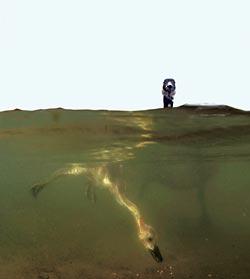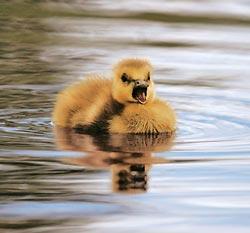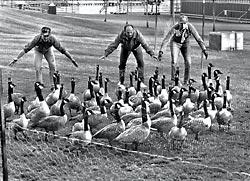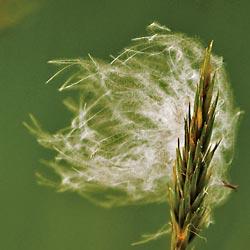A Little Goose Poop

MANY SEATTLEITES believe that the city has too many Canada geese.
They say the birds and their abundant fecal matter have ruined picnics, golf games and sunbathing. They worry that the birds spread disease and create safety problems at airports. To these folks, geese are basically large flying rats that the government should round up and exterminate by the thousands.
I am not troubled by Canada geese, but I rarely go on picnics, I play only miniature golf, and I don't go to beaches to sunbathe or swim. When a skein of geese flies over my neighborhood, I celebrate that these symbols of wildness still grace my city, although I have stepped in my fair share of goose poop and have not been happy about it.
Whatever my sentiments, the birds have lost out. In 2000, federal agents captured 3,500 geese from around Puget Sound, put them in specially designed trucks and gassed them to death. The first killing took place in summer, when neither adults nor their offspring can fly and when the birds are most noticeable, hanging around and pooping in parks. The extermination was considered such a success that agents for Wildlife Services, a division of the U.S. Department of Agriculture, killed 4,200 more birds in 2001 and had a permit to kill 4,200 again in 2002.
Rarely has any species undergone such a complete reversal of opinion, particularly an animal that is neither a predator nor a threat to our safety. The simple solution of killing the geese reinforces an unrealistic cause-and-effect relationship between humans, animals and the environment. If we are going to solve this perceived problem of too many geese, then we need to take a look at why the geese are in Seattle, why they thrive here, and what realistic, biologically appropriate actions can limit their numbers?
SEATTLE'S CANADA goose story begins in 1968. Before then, geese did not nest west of the Cascade Mountains. Lack of habitat had historically prevented the birds from making homes on the wet side of the mountains, although they migrated through. By the early 1960s, however, Seattleites had replaced the primary barriers to geese — big trees and dense understory along shorelines — with lush parks, yards and golf courses. Paradoxically, while Seattleites were creating ideal habitat for the birds, Canada geese populations across the United States had steadily dropped because of over-hunting, unrestricted egg harvesting and habitat loss.
When biologist Harold Hansen "discovered" a wild flock of giant Canada geese in 1962, he started a frenzy among biologists to breed the birds to try to reintroduce them to their former habitats and place them in new habitats. In the Northwest, this rush to save "our grandest waterfowl" manifested itself in a project called Operation Mother Goose. Its goal: Save Canada goose eggs from inundation by water rising behind the John Day Dam on the Columbia River in Eastern Washington. Biologists would release the Mother Goose hatchlings back along the Columbia and introduce them to previously goose-free areas. Dam construction had cut in half the number of geese along the Columbia and Snake rivers, the state's most important nesting areas. The wildlife managers did not trust the population to rebound without intervention.
Operation Mother Goose began on April 11, 1968, 17 miles up the Columbia from the nearly complete dam. Early in the morning, about 25 men from the state Department of Game and the U.S. Bureau of Sport Fisheries and Wildlife gathered at a small island, then spread out in powerboats to collect eggs from nests on 25 to 30 islands in the 70 miles of river that would be flooded less than a week later.
Once an egg was collected, it was placed in a cardboard box insulated with goose down from the nests. When enough eggs accumulated, the boxes were lashed onto a rack on a helicopter and whisked 50 miles northeast to the Kennewick Game Farm, one of several facilities across the state that raised game birds for hunting. Biologists shined a light into each egg to determine the stage of development and placed it into incubators. The entire process took about two hours.
"We picked up about 1,200 eggs," recalled Curt Hedstrom, who managed Kennewick in 1968. "They started to hatch immediately and continued for 32 days. I was lucky enough to raise 1,000 of them." Within four weeks, each rapidly growing gosling was eating more than a pound of feed a day.
"The idea was to take the young ones and hope that adults who had been there for years would take them under their wing, so to speak," Hedstrom said. Goslings could learn from and join wild flocks and soon graduate to the twice-yearly migration. Hedstrom titled the project Operation Mother Goose because of the imprinting — "whoever raises them, they think that's their mother." The first releases — of 100 birds — into the wild took place at McNary Refuge and McNary Game Farm at the confluence of the Snake and Columbia rivers.
By June 12, more than 900 geese had been distributed, mostly to refuges and game farms near the Columbia. While most regional newspapers covered the event, none answered a niggling question: Did biologists release goslings from the John Day eggs in Seattle? Had Canada geese begun to colonize Seattle before 1968 and no one noticed, or did the Mother Goose youngsters lead to the present 25,000 geese? This is a key point. People pressing for protection of a species often use the argument that the animals were here first, and therefore we ought to learn to live with them or at least make it possible for that species to survive.
But what if people arrived first? In urban landscapes we have heavily manipulated the environment and have often brought, purposefully or inadvertently, alien species with us. People seem to find it easier to justify eliminating "weed" species if the offender isn't native. Even now, starlings and English sparrows, the two most prolific and widespread non-native birds in the U.S., can be killed without a permit.
One of the arguments used during Seattle's first war on geese was that they are non-native. In 1987 the Seattle Waterfowl Management Committee formed to try to alleviate health and safety problems and damage caused by geese. Two years later they hired UW biologist David Manuwal to complete a 12-month study. Manuwal and his group examined 25 parks in the Seattle area, finding between 3,000 and 4,000 Canada geese. He traced the origin of these birds to the John Day eggs, although he neither named Operation Mother Goose nor cited any written documentation for it. Manuwal concluded that the best way to stem the population was to capture and ship back across the mountains up to 90 percent of the birds over five years.
When news of Manuwal's report became public, activists gathered signatures, wrote letters to the editor and protested at public forums. "We think the geese have just as much a right to be here as the people who use the beach,'' Dr. Wayne Johnson of the Northwest Animal Rights Network told the media. "We do not think Canada geese should have to pay with their life because of fecal matter." Johnson added that park officials had not stressed options such as discouraging people from feeding the geese.
Biologists argued that the number of people who actually feed the birds is insignificant. Many of the people who blame the problem on handouts are park and golf-course managers, whose manicured lawns feed more geese than anybody.
In 1991, biologists turned the "native versus wild" point on its head by arguing that removing the geese from the city would be a huge benefit to the birds. Bill Rybarczyk of Idaho Fish and Game told one local paper at the time, "We're trying to put them back in the wild where they can breed, bring up young and establish a new free-flying population of Canada geese." Public officials agreed with biologists, and goose collection began in the summer of 1991. Federal biologists gathered 2,524 birds and shipped them east. A year later they transported 1,731 more, followed by 519 in 1993. The number dropped not because this action succeeded but because Idaho didn't want any more birds. Our problem had become Idaho's.
Deportation did lead to a downturn in numbers, but not for long. An August 1993 aerial census found only 2,315 geese in Seattle, although biologists predicted that if no further action was taken, the population would double in five years. Urban Canada geese produce up to 15 eggs per nest and can quickly build their numbers.
BY THE END of the 1990s, the urban goose population had reached critical proportions. Beaches were closed because of too much goose poop, and complaints flowed in to park officials. This led to a 1999 environmental assessment on resident Canada geese in the Puget Sound area. Lead author Keel Price, a biologist for the USDA, concluded that killing 3,500 birds would be the best solution to slow the growth.
Price used the bird's introduction as a justification for his findings. He also alluded to Operation Mother Goose without citing specific documentation. The Department of Fish and Wildlife "destroyed all their records when it became obvious that they had probably caused this problem," Price told me.
Contrary to Price's statement, officials did produce a paper trail — a series of annual analyses called the "Small Game Reports," but none mentions bird releases around Seattle.
The closest locale was the South Tacoma Game Farm. Bud Angerman, former head at Tacoma, was the first person to say that Mother Goose birds crossed the Cascades. "We wanted to start a captive program because we had good habitat. We received 10 to 15 goslings from Kennewick . . . and soon we had too many, so we sent some to Yakima and to Capital Lake in Olympia."
He did not, however, release any in Seattle. "I remember that geese were already there," Angerman said. Most likely they were migratory birds. Angerman suggested I contact Curt Hedstrom to see if he had sent any west.
"There were some planted near Lake Washington. In fact they are a nuisance there right now. I don't know how many of them were my geese," Hedstrom said.
About a week after I spoke to Hedstrom, an envelope from him arrived at our house. The half-dozen newspaper articles inside contained details on Operation Mother Goose, photos of officials collecting eggs, men in hunting caps boxing the eggs, and several shots of cute goslings.
I tried Hedstrom again, wanting more specifics. "In regard to Lake Washington, I don't think they were planted right on the lake. I can't tell you for sure, but I see no reason that they would . . . They wouldn't plant an area where people didn't want the geese. They didn't just nonchalantly plant them. They must have had a reason."
Hedstrom may not have realized it, but he did offer the first reason why Canada geese might have been released near Seattle. "The Game Department works for the sportsmen. They're the ones that paid our wages," he said. The geese would help establish a flyway where hunters might have a chance to shoot the birds.
Maybe we should let the sportsmen back into the picture. If hunters could hunt Seattle's geese, we might have fewer complaints, or at least fewer birds. Obviously this won't happen in an urban landscape, but it does point out one of the reasons geese prosper here. No one eats them, and urban dwellers don't allow goose predators to live in our midst.
In any case, we should not blame Operation Mother Goose for our problem. The biologists thought they were preserving a cherished species. Moreover, they were not alone; at least 40 states tried to acquire goslings from Operation Mother Goose. The same agency that ran Mother Goose, Sport Fisheries and Wildlife, also encouraged individuals to get involved. In 1971 they published a guide titled "Home Grown Honkers." The authors devoted a long section to urban areas and offered a surprisingly prescient caveat: "We also conclude that, while honkers are a definite asset in many cases, they may become a nuisance in others."
We will probably never be able to state definitively the number of Mother Goose goslings released around Puget Sound, but they would not have stayed if we hadn't done such a fine job of altering the landscape. As one wildlife manager said, "Mother Goose merely sped up the process" of the population boom.
The population has grown, in part, because the creation of goose heaven led to a significant change in the lifestyle of urban geese. That familiar flight of honkers crossing the sky is probably a flock of wild geese during the annual fall or spring migration. Unlike their feral relatives, urban geese do not migrate. Why should they? Animals migrate because they need a better place to eat, breed or live, and no goose is going to find a better spot than Seattle. And urban geese also have a significantly higher survival rate than their wild relatives. Around 90 percent of the birds in a city survive their first year compared with 60 percent for wild populations. Those that make it to their first year also live longer than wild birds, because the main cause of mortality for wild adults is hunting.
It's not that people do not like Canada geese; it's that people do not like what the birds produce. Geese are walking digestive tracts disguised as birds, defecating 28 times a day, or up to 92 times per day in winter. A single bird can produce 3 pounds of droppings per day. (Geese, like all birds, combine urine and excrement in one tidy package, which ornithologists call droppings.)
Whether fecal output causes diseases, however, is less clear. Dr. Milton Friend, past director of the National Wildlife Health Center, a biomedical laboratory that assesses the impact of disease on wildlife, says geese pose few, if any, problems as a disease vector to humans.
Yet, the perceived threat of disease drives many of the calls for eliminating the birds. Geese droppings have been blamed for closing beaches across the region, although recent reports show that house pets contribute a significant fecal coliform load and it is hard to pinpoint a single source considering how much material, such as spilled oil, sewage overflow and road runoff, drains into our lakes and streams.
Science, however, does not play much of a role in the public perception of the goose problems. It is an emotional issue, and for many the simple answer is one once uttered by Arlo Guthrie in his infamous "Alice's Restaurant": "Kill! Kill! Kill!" Officials choose extermination because it may slow down the population explosion. Studies show, however, that Canada geese populations can remain steady or increase even with adult mortality rates of 40 percent, which means that public land agencies will be forced to continue to kill.
So far, no one has shown that the birds are doing any damage to other animals or to the environment, but if the upward population trend continues, biologists predict that more than 100,000 Canada geese could dwell in Puget Sound by 2014. Who knows what impact so many large waterfowl will have on other species?
Perhaps both camps are wrong, their solutions too simple and disconnected from science. You have to wonder, if we cannot learn to live with these relatively harmless and rather handsome animals, whose only problem is that they poop too much, how will we ever live with species whose impact may be far less benign?
David B. Williams of Seattle is a freelance natural-history writer who has contributed to Smithsonian, Popular Mechanics and National Parks magazines.
Tom Reese is a Seattle Times staff photographer.








Today's piece is excerpted from "The Street-Smart Naturalist: Field Notes from Seattle" by David B. Williams, with the permission of WestWinds Press, an imprint of Graphic Arts Center Publishing.
Williams will be reading: July 27, 7 p.m., at Bailey/Coy Books, Broadway Avenue, Seattle; July 28, 7 p.m., at Eagle Harbor Books, Bainbridge Island; Aug. 16, 7 p.m., at Green Leaf Books, Seattle.